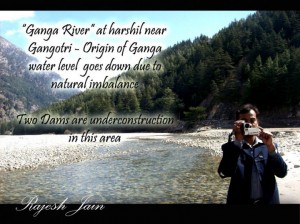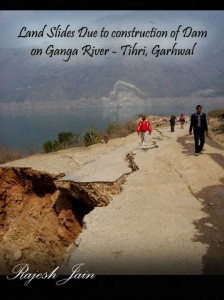Childwellness – Uttaranchal Cuisine

http://hindupad.com/gangotri-yatra-2010
Uttaranchal was a state of India. On 9 November 2000 Uttaranchal was carved out of Uttar Pradesh as a separate state. In January 2007, the name of the state was officially changed from Uttaranchal, its interim name, to Uttarakhand. Uttarakhand (Sanskrit: उत्तराखण्डम्, Hindi: उत्तराखण्ड UttarÄ�khanḍ) is a state located in the northern part of India. Known for its natural beauty, it was carved out of Himalayan and adjoining districts of Uttar Pradesh on 9 November 2000, becoming the 27th state of the Republic of India. It borders the Tibet Autonomous Region on the north, Nepal on the east and the Indian states of Uttar Pradesh to the south, Haryana to the west and Himachal Pradesh to the north west. The region is traditionally referred to as Uttarakhand in Hindu scriptures and old literature, a term which derives from Sanskrit uttara (उत्तर) meaning north, and khaṇḍ (खण्ड्) meaning country or part of a country. It has an area of 20,682 sq mi (53,566 km²). In January 2007, the name of the state was officially changed from Uttaranchal, its interim name, to Uttarakhand. The provisional capital of Uttarakhand is Dehradun which is also a rail-head and the largest city in the region. The small hamlet of Gairsen has been mooted as the future capital owing to its geographic centrality but controversies and lack of resources have led Dehradun to remain provisional capital. The High Court of the state is in Nainital.
Recent developments in the region include initiatives by the state government to capitalise on handloom and handicrafts, the burgeoning tourist trade as well as tax incentives to lure high-tech industry to the state. The state also has big-dam projects, controversial and often criticised in India, such as the very large Tehri dam on the Bhagirathi-Bhilangana rivers, conceived in 1953 and about to reach completion. Read more: > HERE <
Childwellness – orphans, neglected children and children of poor families. Therefore we provide them with food, healthcare and education. If necessary we also look for permanent and stable homes in their own environment, for and a loving family form the necessary basis for a child to grow up in a balanced way. To achieve this, objectives. You can find an overview of our selections further in this presentation folder click here.
Childwellness task is to raise funds in order to support these projects financially. For that,sponsoring activities are organised annually. By means of participation of grants and festivals, Childwellness aims to reach a larger public. Furthermore Childwellness tries to find companies, associations, schools and other agencies for possible sponsoring. If you are able to help us with this, please contact us. Childwellness is also looking for monthly sponsors who want to financially support our projects on a regular basis.
Vivekananda Residential Tribal School (Vidyalaya, Wayanad District, Kerala, India) – The school has approximately 250 children, and it specifically works with tribal children. Most of them are orphans: they’ve lost their father and/or mother and therefore live permanently at school. Tribals are a very vulnerable group of people in India because they don’t belong to any caste. They are also economically extremely vulnerable because they can no longer live in their natural surroundings: their forest has become a National Reserve.
The children receive an education, a uniform, and 3 meals a day. One child in this school costs 10 Euro/month (8.93 GBP or 14.92 USD; currency of November 14, 2009) with everything included. Presently, the most important need of this school is a dormitory with 150 beds for the boys. Childwellness hopes to sponsor this dormitory as much as possible.
Childwellness supports educational projects in India. We want orphans and children of poor families to have access to a comprehensive education because good school training is of huge importance for the future of every child. Childwellness wants to prevent parents or other family members from sending young children to work to earn money, which results in them missing important chances in life. As fact, India remains a country with a significant prevalence in child lab.
“ASIA FAIR” For the first time in its existence. Childwellness took part in the “Asia Fair”, a unique event with a large turnout ! We still look back on the success of the weekend, where a number of significant contacts for the future were made.
Uttaranchal Delicious Cuisines – „I am damn sure that a true lover of food will understand the value of this group.“ The traditional cuisine of the land is highly nutritious, simple to prepare and at the same time appealing to the palate. You can have delicious and mouth-watering Pahari recipes from Garhwal and Kumaon region of Uttaranchal. Hope you will enjoy the recipes…….
http://www.internationalrivers.org/-himalayas-dam-boom
Audio Slideshow: Mountains of Concrete – A dam-building boom in the Himalayas in times of global warming is like investing billions of dollars in high-risk, non-performing assets …
Gangotri (Hindi: गंगोत्री) is a town and a Nagar Panchayat (municipality) in Uttarkashi district in the state of Uttarakhand, India. It is a Hindu pilgrim town on the banks of the river Bhagirathi. It is on the Greater Himalayan Range, at a height of 3,042 m. Gangotri, the origin of the river Ganga and seat of the goddess Ganga, is one of the four sites in the Char Dham pilgrimage circuit. The river is called Bhagirathi at the source and acquires the name Ganga from Devprayag onwards where it meets the Alaknanda. The origin of the holy river is at Gaumukh, set in the Gangotri Glacier, and is a 19 km trek from Gangotri. Gangotri can be reached in one day’s travel from Rishikesh, Haridwar or Dehradun, or in two days from Yamunotri, the first site in the Char Dham circuit. More popular and important than its sister site to the east, Gangotri is also accessible directly by car and bus, meaning that it sees many more pilgrims than Yamunotri. Read More: > HERE <
This small town is centered around a temple of the goddess Ganga, which was built by the Nepalese General, Amar Singh Thapa in the early 18th century. The temple is closed on Diwali day every year and is reopened in May. During this time, the idol of the goddess is kept at Mukhba village, near Harsil.
Ritual duties are supervised by the Semwal family of pujaris. The aarti ceremony at the Gangotri is especially impressive, as is the temple, a stately affair that sits on the banks of the rushing Ganga. Adventurous pilgrims can make an overnight 18 km trek to Gaumukh, the actual current source of the river Ganga.
Bhagirathi River at Gangotri. For a large number of tourists, Gangotri town serves as the starting point of the Gangotri-Gaumukh-Tapovan and Gangotri-Kedartal trekking routes.
The Ganges (also Ganga DevanÄ�garÄ�: गंगा) is a major river in the Indian subcontinent flowing east through the eponymous plains of northern India into Bangladesh. The 2,510 km (1,557 mi) long river begins at the Gangotri Glacier in the Indian state of Uttarakhand in the central Himalayas and drains into the Bay of Bengal through its vast delta in the Sunderbans. It has enjoyed a position of reverence since millenia among India’s Hindus, by whom it is worshipped in its personified form as the goddess Ganga (see below). The Ganges and its tributaries drain a large and fertile basin with an area of about one million square kilometres that supports one of the world’s highest density human populations.

Shockingly, this dam boom is not being analyzed for the biggest threat to hydrological projects of our time: global warming. “The possible impacts of climate change are not being considered – neither for individual dams, nor cumulatively,” says Shripad Dharmadhikary, author of Mountains of Concrete: Dam Building in the Himalayas.
A dam-building boom in the Himalayas in times of global warming is like investing billions of dollars in high-risk, non-performing assets. In the Himalayas, „melting glacier water will replenish rivers in the short run, but as the resource diminishes, drought will dominate the river reaches in the long term,“ says Xin Yuanhong, a senior engineer with a Chinese team that is studying the glaciers of the Tibetan plateau.
The International Centre for Integrated Mountain Development, ICIMOD, in Nepal and the Intergovernmental Panel on Climate Change agree that global warming will also lead to more storms and floods, especially in tropical and mountainous regions. A report by ICIMOD on the impact of climate change on Himalayan glaciers states: “On the Indian subcontinent, temperatures are predicted to rise between 3.5 and 5.5°C by 2100. An even higher increase is predicted for the Tibetan Plateau. Climate change is not just about averages, it is also about extremes. The change in climate is likely to affect both minimum and maximum-recorded temperatures as well as triggering more extreme rainfall events and storms.” These heavy storms and floods will jeopardize the economic profitability of hydropower projects, as well as the safety of these mountains of concrete.The sudden bursting of glacial lakes is another major concern for the safety of planned dams, and ultimately the rivers and peoples of the Himalayas. Glacial lake outburst floods (GLOFs) are a recent phenomenon. As glaciers in high-altitude regions such as the Himalayas melt, they can form large lakes behind temporary dams of ice and rock. When these moraine dams collapse, millions of cubic meters of water are released, resulting in massive flash floods. The Dig Tsho GLOF in Nepal in 1985 was one of the most devastating glacial lake bursts in recent history. The bursting of this glacial lake near Mount Everest caused a huge flood wave that travelled down the valley, killing five people and destroying one hydropower station, many acres of cultivated land and 14 bridges.
Hydropower projects and Climate Change Himalaya « Climate Himalaya
http://chimalaya.org/category/hydropower-projects-and-climate-change-himalaya/Himalayas hydroelectric dam project stopped after scientist on hunger strike against the project almost diesEminent Indian professor calls off fast after government agrees to speed up inquiry into river flow in sacred Gangeshttp://www.guardian.co.uk/environment/2009/mar/13/himalaya-dams
Himalaya May Become Most Heavily Dammed Region of the World | Blue … Over one billion people rely on the waters of the Himalaya for survival, and massive dam building will negatively affect this important source of water. South Asia should look at other sources of renewable energy, as dams have been proven to be detrimental to ecosystems in America. Damming Asia will not solve the world water crisis while meeting the energy needs of this growing region.
http://bluelivingideas.com/topics/climate-change/himalaya-heavily-dammed-region-world/
Unaware of risks
The Himalaya is one of the fastest changing regions of the world due to global warming. The mountains’ mighty glaciers, the source of large and important rivers such as the Ganga, Indus und Brahmaputra, are melting. In February 2009, Chinese scientists warned that glaciers on the Tibetan plateau are melting at a “worrisome speed“, threatening South Asia’s water supply. In spite of this dramatic trend, the governments of India, Pakistan, Nepal and Bhutan are planning to transform the Himalayan rivers into the powerhouse of South Asia. They want to build hundreds of mega-dams to generate electricity from the waters of the Himalayas.
Devastating lake bursts
The sudden bursting of glacial lakes is another major concern for the safety of planned dams, and ultimately the rivers and peoples of the Himalayas. Glacial lake outburst floods (GLOFs) are a recent phenomenon. As glaciers melt, they can form large lakes behind temporary dams of ice and rock. When these moraine dams collapse, millions of cubic meters of water are released, resulting in massive flash floods. The Dig Tsho GLOF in Nepal in 1985 was one of the most devastating glacial lake bursts in recent history. The bursting of this glacial lake near Mount Everest caused a huge flood wave that travelled down the valley, killing five people and destroying one hydropower station, 14 bridges and many acres of cultivated land.
In January 2009, the government of Bhutan identified more than 2,600 glacial lakes in the country, of which 25 are considered to be at high risk of bursting, according to Bhutan’s Department of Geology and Mines. While Bhutan is aware of the risk of GLOFs and is improving its early warning system, the country, together with India, is still currently constructing one of the largest hydropower dams in the region, the 90-meter-high Tala project on the Wangchu River.
One billion people in South Asia and many millions in China depend on the Himalayan rivers – for agriculture as well as for drinking water supplies. While we can’t predict the future course of change to these lifelines from global warming, we can no longer presume that there will always be abundant snow and glaciers in the Himalayas, feeding Ganga, Indus und Bhramaputra with as much water as in the last 50 years.
While we can’t predict the future course of change to these lifelines from global warming, we can no longer presume that there will always be abundant snow and glaciers in the Himalayas. If the Himalayan governments go forward with their planned dam boom, they deny that global warming is actually transforming their region and our planet.
China’s Himalayan plan: Dam on Brahmaputra – He said the proposed project’s greatest risk for India and Bangladesh is seismic activity and not water diversion. The laws of physics will not allow water diversion from the great bend, he wrote on the blog.
The blog post also listed an alternative unofficial proposal at a 2,400 m drop in altitude at Daduqia.
“But it is near the border with India and would be highly exposed if there were another conflict,’’ he wrote.
http://www.hindustantimes.com/China-s-Himalayan-plan-Dam-on-Brahmaputra/Article1-548572.aspx
Pollution and Climate Change in Himalaya « Climate Himalaya Initiative –http://chimalaya.org/category/pollution
The Himalayan headwaters of the Ganges river in the Uttarakhand state of India. … There, a dam diverts some of its waters into the Ganges Canal, ….. In 2007, the Intergovernmental Panel on Climate Change (the „IPCC“), in its Fourth … http://en.wikipedia.org/wiki/Ganges
Mountains of Concrete: Dam Building in the Himalayas
http://www.scribd.com/doc/8808220/Mountains-of-Concrete-Dam-Building-in-the-Himalayas
Dams and the Worldbank – The World Bank is the greatest single source of funds for large dam construction, having provided more than US$50 billion (1992 dollars) for construction of more than 500 large dams in 92 countries. The World Bank has been „directly or indirectly associated“ with around 10% of large dams in developing countries (excluding China, where the Bank had funded only eight dams up to 1994). The importance of the World Bank in major dam schemes is illustrated by the fact that it has directly funded four out of the five highest dams in developing countries outside China, three out of the five largest reservoirs in these countries, and three of the five largest hydroplants. http://www.whirledbank.org/environment/dams.html
„Clean Energy for the Poorest Countries“ ~ World Bank Drawing on examples from Asia, Africa and the Americas, Survival’s report Serious Damage exposes the untold cost of obtaining ‘green’ electricity from large hydroelectric dams. A rapid increase in global dam-building is currently under way. The World Bank alone is pouring $11bn into 211 hydropower projects worldwide.
The World Bank’s current focus is on the achievement of the Millennium Development Goals (MDGs), lending primarily to „middle-income countries“ at interest rates which reflect a small mark-up over its own (AAA-rated) borrowings from capital markets; while the IDA provides low or no interest loans and grants to low income countries with little or no access to international credit markets. http://en.wikipedia.org/wiki/Millenium_goals

Comments are closed.
